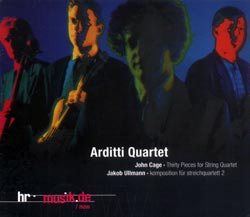
Cage's "Thirty Pieces for String Quartet" (1983) is a problematic creation for the recorded medium. The work is through-composed, thirty sections for each member of the quartet (so that it might as accurately be referred to as 120 pieces). However, in performance, the string players are to be set in far corners of the room, far enough away from one another that they cannot actually hear what anyone else is playing. This spatial and, necessarily it would seem, temporal dimension is impossible to reproduce on disc and, as far as what's indicated in the liner notes, no such effort was made during the recording process. That being said, the listener is still left with a half-hour of fairly invigorating music. It proceeds on an even keel, the general volume level consistently strong throughout. The language and phrasing employed is of a common modern kind: no very extreme techniques, at least none that weren't in routine play in the 1950s which is somewhat surprising and even a bit disconcerting — the vocabulary has tinges of the academic about it, despite being expertly played. The attacks, the decays and the flourishes all seem derived from the argot of several decades prior; perhaps this was Cage's intention. But it flows well and seamlessly, unfurling like a carpet, albeit a slightly fusty one.
Ullmann's "komposition für streichquartett 2" (1998/99) is something else entirely, aside from that fact that it too maintains a uniform dynamic level throughout-except that level is well down in the pianissimo range. It's like looking out on a landscape where there's all manner of intense activity occurring but it's all happening within an inch of the ground. The sounds tending toward the softly scraping and tapping but here and there, pure tones emerge, tones that seem positively lush and melodic in this context. Rohan de Saram, in particular, manages to imbue his playing with astonishing richness given how delicately the cello had to have been touched. But it's the scurrying activity that's redolent of deep intelligence, however alien, that really captivates the listener and makes this work utterly entrancing. One can't cease attempting to interpret all the sounds one can perceive even as you're straining to hear more. It manages to attain the quality of an excellent field recording, so natural and restrained are the sounds, whispering by like moths in low-lying fog. It's a major work, beautifully realized by the Arditti.
Comments and Feedback:



More Recent Reviews, Articles, and Interviews @ The Squid's Ear...


|

